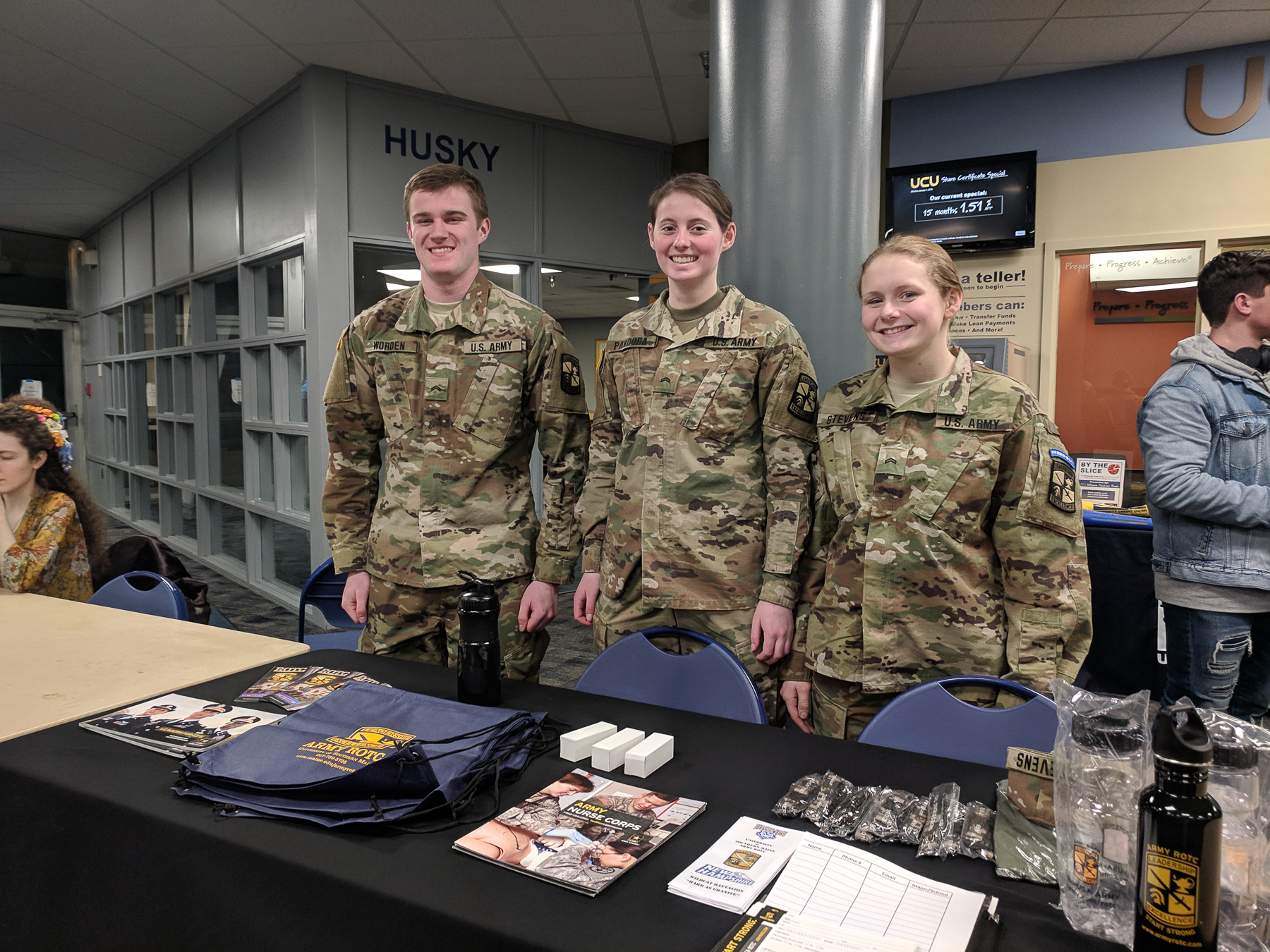By Nick Schleh, Staff Writer
The Army Reserve Officer Training Corps (ROTC) program provides a community for students at USM interested in leadership roles in the U.S. Army. USM’s program joins together with other New England universities to form a combined total of 145 Cadets, with 30 of them attending USM. USM’s ROTC students form the Bravo company, a group amongst thousands of other ROTC students across the nation. The majors within Bravo company range from environmental science, military science and English among others. The ROTC program has an office in Gorham on School St. Two Cadets interviewed said they often call it the “clubhouse.”
Students in the ROTC program fulfill a minor requirement for their degree. There are four ROTC classes offered, and students take one a year. The first-year course, Introduction to ROTC, teaches students of the role the army has had in history. They cover individual warrior skills and tasks, squad level tactics and basic drills, land navigation and basic physical fitness. The second-year course, Team Tactics, teaches students leadership skills, first aid and trauma triage, principles of war, small unit combat operations and public speaking. The third-year course focuses on the laws of war, platoon level tactics, squad leadership in combat operations and command & staff functions. The final course for seniors prepares students for leadership developments of subordinates, combat intelligence, national strategy, physical fitness for teams and platoons as well as Army personnel management systems.
The motivation for students to join varies, from a family with a military history to students looking for help in school. Megan Bennett a senior Cadet, joined because both of her parents served in the military and she wanted to continue the family tradition. Jenny Stevens, a sophmore Cadet, said she was hesitant at first, but joined because her mother is in the Air Force. Now, she says, she cannot believe she ever considered not joining.
Cadet Isaac McIntire said that the ROTC program has given him structure. “When you’re in college and have all your classes it’s more or less free form… with the ROTC there are standards and you have to meet those. It gives you something to look forward to.” Nicholas Roberts joined the ROTC program to help pay for school, a common reason shared amongst many of the students in Bravo Company.
The ROTC program offers scholarships for its students that cover tuition, fees, room and board, textbooks, as well as a monthly stipend of up to $500. The scholarships are awarded to students based on merit, not financial need. Merit, according to the ROTC program website, is exhibited through academic achievement and extracurricular activities, such as student government, sports, or having a job outside of school. The ROTC nursing program has its own set of scholarships for second, third and fourth year students that include full tuition, $1,200 towards books, reimbursement towards uniforms and equipment and a monthly stipend that varies on what stage the student is in their education.
Out of state students that join the ROTC program at USM are granted in-state tuition as well as being able to apply for scholarships.
Students in the program have also had opportunity to travel overseas as part of the Cultural Understanding and Leadership Program (CULP). Stevens is going to be in Santiago, Chile this summer to train with the Chilean army and learn about their military’s practices. Roberts is heading to the Congo for military training and to create a rapport with the Congolese military. The summer programs count as internships and usually consist of one colonel, often a military science professor, taking 25 students from various universities to a specific country for military training and to improve relations between the two nations. The trips are prefaced with a one-week training session in Fort Knox, Kentucky. The students partaking in the summer program are also paid for their training. The goal of CULP is to immerse Cadets in foreign cultures and expose them to the differences between nations, whether they be political or economic as stated on their website.
The ROTC Cadets have three group workout sessions a week in the Costello Field House. Also, every Friday the Cadets drive down to UNH to meet with other Cadets and train in the woods on Army tactics, with every grade having a specific 2-hour college class.
Not all students in the ROTC program are on track for deployment. While some ROTC students are deployed overseas after their time at university, many of them take the experiences from their time in the program to pursue careers with non-combat roles, such as accounting, law or medicine.
“We don’t have to stress about what we are going to do after college,” said Cadet Stevens. “A lot of students spend their whole senior year trying to do internships and stuff”.
Major Gregory Hayes, the head of the department, said that the number one thing that he tries to teach his cadets is leadership. Cadet Ronnie Harness agrees, “We are looking out for each other… if we see a person failing, we encourage them and correct them in a positive way to help them out.” Once the Cadets graduate they are commissioned as officers to take their leadership skills into the real world.
Any students interested in joining the ROTC program at USM or are looking for more information, can contact Major Hayes at [email protected].

